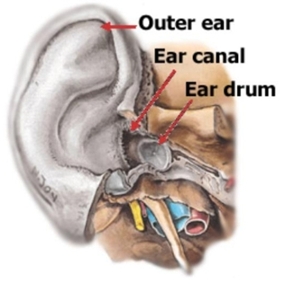Overview
The Ear Consists Of Three Parts :

Outer Ear: The part you can see plus the ear canal leading down to the eardrum.
Middle Ear: The eardrum and ear bones (ossicles), plus the air spaces behind the eardrum and in the mastoid cavities (vulnerable to air pressure).
Inner Ear: The area that contains nerve endings for the organs of hearing and balance (equilibrium
Some Of The Most Common Ear Disorders Include :
- Otitis Media—The medical term for a middle ear infection or inflammation of the middle ear. This primarily affects children due to the shape of the young eustachian tube.
- Tinnitus—Also called “ringing in the ears” includes noises ranging from loud roaring to clicking, humming or buzzing. Most tinnitus comes from damage to the microscopic endings of the hearing nerve in the inner ear. Hearing nerve impairment and tinnitus can be a natural accompaniment of advancing age. Exposure to loud noise is probably the leading cause of tinnitus damage to hearing in younger people.
- External Ear Infections—Also called Swimmer's Ear are infections of the outer ear structures that may occur when water gets trapped in the ear canal. In this warm, moist environment, bacteria multiply causing irritation and infection of the ear canal.
- Ear Wax (Cerumen)—Cerumen is produced by special glands in the outer part of the ear canal designed to trap dust and dirt particles keeping them from the eardrum. Usually wax accumulates, dries and then falls out of the ear on its own or is wiped away. Other times this may require removal by a physician.
- Autoimmune Inner Ear Disease (AIED)—is an inflammatory condition of the inner ear that occurs when the body's immune system attacks cells in the inner ear that are mistaken for a virus or bacteria.
- Cholesteatoma—is a skin growth that occurs in the middle ear behind the ear drum. This condition usually results from poor eustachian tube function concurrent with middle ear infection (otitis media), but also can be present at birth.
- Perforated Eardrum—occur when there is a hole or rupture in the eardrum, which is the thin membrane that separates the ear canal and the middle ear. Sometimes a perforated eardrum will heal spontaneously, other times surgery to repair the hole is necessary.
For more information, medical assessment and medical quote
as email attachment to
Email : - info@wecareindia.com
Contact Center Tel. (+91) 9029304141 (10 am. To 8 pm. IST)
(Only for international patients seeking treatment in India)










